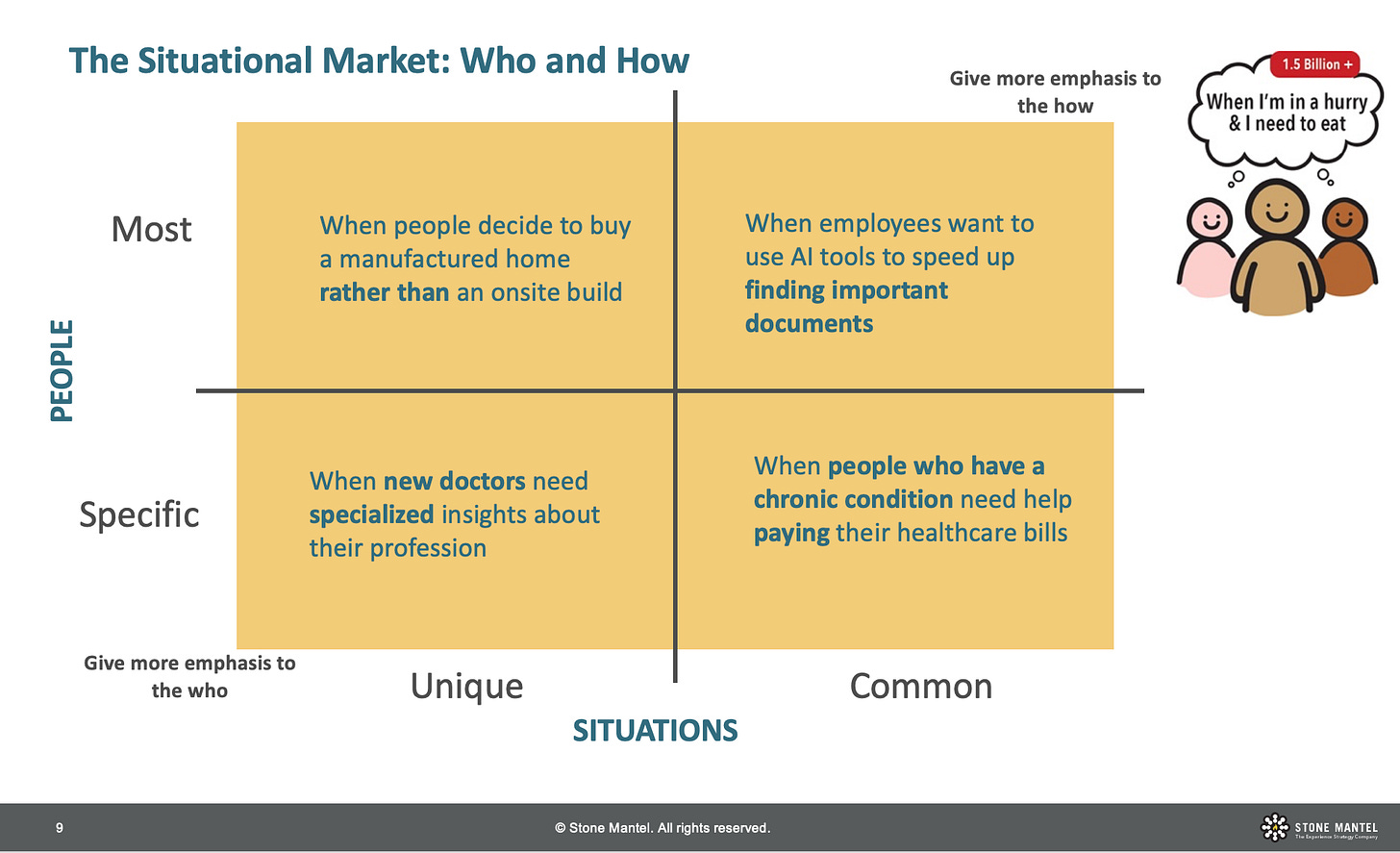A Situation Starts with a 'When'
Chapter 2: Principle 1—Growth comes by Capturing Situational Markets
Friends,
I want to thank those of you who are sending me feedback on what you value from the writing. Please keep it coming. And please share this post with three people who need it!
This is one of my favorite posts for the book. To me it seems so obvious now that I can’t imagine why companies don’t already do this. In some ways, I think this post stems from years of work in usability studies, use case development, and so forth.
See if you agree.
As always, at the bottom is the outline of chapters 1 and 2 with links to the sections.
A Situation Starts with a ‘When’
Let’s imagine that you are the strategist for a large multichannel retailer. You want to your company revenue to grow. So, you start to assess your company’s ability to gather data regarding situations. How do you determine what constitutes a situation? The answer is you describe a situation with a ‘when.’ For example, you might want to start by describing common situations in which people often buy things:
When people are working at home
When people are watching TV
When people are traveling
When people are on vacation
When people are in the store but can’t find what they want
When people are home and feeling sick
When people are hungry and not home
When people are helping a family member
Notice that the ‘when’ is followed by a generic descriptor of the who, ‘people,’ followed by both common and more unique explanations. ‘When’ keeps you focused on the situation.
In some cases, the ‘when’ doesn’t make much sense unless you are clear about the ‘who.’ In those cases, you need to emphasize the ‘who’ too. If the retailer only sells clothing for children, then the statement needs to adjust to ‘when parents of small children are working from home.’
In fact, we can think about situations that arise using the following criteria. Is the situation unique or common? And, are the people who experience the situation ‘specific’ or ‘most’?
If we have unique situation for specific people then your when statement will likely need to emphasize the who. In the case of the table above: ‘when new doctors need specialized insight about their profession.’ If the situation is common and arises for most people, then your when statement will probably focus more on the how. For example: ‘when employees want to use AI tools to speed up finding important documents.’ Being ‘an employee’ is a very general descriptor. ‘Using AI to speed up finding important documents’ describes the opportunity.
Once you have a starting set of ‘when’ statements, you can begin to determine how you might collect data about these situations. Does time of day, usage patterns, seasons, routines, or software usage tell you anything about the situations? Like the Red Roof Inn example, the more data points you have the more likely you are to identify situations or even predict situations for customers.
Don’t despair if you cannot immediately gather contextual data for all situations. Traditional qualitative and quantitative survey tools can help you to size your market opportunity.
Sizing Your New Markets
‘Frequency’ is the key word for growing a situational market. Frequency is a calculation of number of people who experience the situation and number of times the situation arises – or could arise, if there were a solution for the situation.
Here are two different ways to arrive at the size of the market opportunity.
My guess is that for most companies, the market frequency for common situations will be in the billions, not millions.
You can prioritize situational markets. Start with the most common situations that are core to the job your company does for your customers. Then move on to more unique situations or situations that are likely to be near future needs. We might call those situations, ‘scenarios.’ For example, “when most people are able to order groceries via drones.”
Use generative AI to help you think about potential situations and scenarios, but then spend time with actual people learning about how they accomplish their goals when situations change. A company should have a sizable list of market opportunities.
What you will find as you start to focus on customer situations is that people are the constants and it’s the situation that they find themselves in that you must customize for. Your company will become far better at personalizing experiences when you focus on common situations. Your paradigm will shift from studying customer preferences (again a ‘who’ activity) to understanding how situations affect people’s needs. You will need to customize less per individual while creating more value for many more people.
Click here for book outline with links to posts
This post about Experience Strategy Certification is also helpful.





